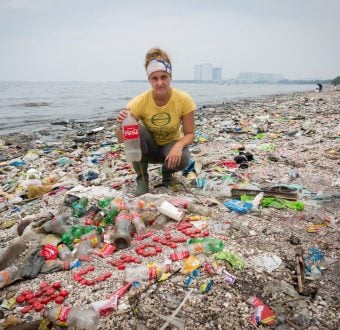“By leading the way in eliminating the potential consequences of a catastrophic terrorist attack or accident, Clorox’s announcement also provides Congress with compelling new evidence to enact chemical plant security legislation,” said Rick Hind, Greenpeace legislative director. Coincidentally, chemical security legislation (H.R. 2868) is slated for a vote in the House of Representatives this Wednesday. If enacted it would require the highest risk chemical plants to convert to safer cost-effective chemicals wherever feasible just as Clorox plans to do.
“By ending the use of chlorine gas, Clorox also proves that eliminating these risks is both technically feasible and a smart business decision. Switching to safer substances not only reduces liability and regulatory obligations, it also enhances profitability and long-term job security. Eight years after the 9/11 attacks, the Clorox announcement leaves no excuse for other industry giants such as Dow and DuPont. Their plants put potentially millions of Americans at risk. View Dow map and Dupont map. Given the time it can take to convert, it is urgent that these firms start following Clorox’s lead now,” said Hind.
In February, Greenpeace wrote Knauss asking for a meeting to discuss ways to eliminate these risks. Greenpeace sent similar letters to Dow and Dupont. Soon after, Knauss responded and invited Greenpeace to a meeting with him and other executives at their Oakland, California headquarters in May. At the meeting Knauss unveiled their plans and explained the economic, security and safety benefits that executives factored into their decision. Following the meeting, Greenpeace was also given a tour of the Fairfield, California plant, which will be the first Clorox production facility to convert.
Clorox’s statement today includes the many benefits of converting that Knauss cited such as: “minimizing business disruption, strengthening operations, reducing potential supply chain constraints, complexity and risks, increasing security, the company’s costs, including volatility and increases in raw materials…risks relating to the handling and/or transportation of hazardous substances including but not limited to chlorine…” http://investors.thecloroxcompany.com/releasedetail.cfm?ReleaseID=420583
Because Clorox is a member of the National Association of Manufacturers (NAM) which is lobbying against the House chemical security legislation, Greenpeace also asked Clorox to support the pending legislation. Clorox has not taken a position on the pending legislation.
However, the Association of American Railroads (AAR), some of whose member companies are also NAM members, issued a strong statement on this legislation in 2008 saying, “It’s time for the big chemical companies to do their part to help protect America. They should stop manufacturing dangerous chemicals when safer substitutes are available. And if they won’t do it, Congress should do it for them.”
The current law actually bars the Department of Homeland Security (DHS) from requiring the use of safer chemicals or processes. The current law also exempts all (2,600) water treatment facilities, some of which use large quantities of chlorine gas. “Just as we require airplanes to be safer, clearly the chemical security law must be strengthened to ensure the use of safer chemicals wherever alternatives are possible,” said Hind.
On October 1st, in testimony before Congress, the Obama administration’s DHS and Environmental Protection Agency officially called for permanent legislation that requires the highest risk chemical plants in all sectors to use safer more secure chemical processes wherever possible. In 2006, when Senators Obama and Biden championed nearly identical legislation that was opposed by the chemical industry, Obama said, “We cannot allow chemical industry lobbyists to dictate the terms of this debate. We cannot allow our security to be hijacked by corporate interests.”
The cost of converting a plant is insignificant compared to its liability in the event of a terrorist attack or accident. According to the New York City Comptroller, the economic impacts of the 9/11 attacks were $94.8 billion. Safer chemical processes also ensure a more reliable supply chain and fewer regulatory obligations. More than 87 percent of converted facilities surveyed reported conversion costs of $1 million or less and one third expect to save money. The Center for American Progress produced a report listing 284 examples of facilities that have converted since 1999 at: http://www.americanprogress.org/issues/2006/04/b681085_ct2556757.html/chem_survey.pdf
Other companies have also recognized the potential profitability of safer chemical processes. For example, K2Pure Solutions plans to build safer bleach making facilities in California, New Jersey and Illinois. For more information, see: www.K2Pure.com
Since the 9/11 attacks, chemical plants have been identified as one of the most vulnerable sectors of U.S. infrastructure to terrorism. Over 100 million Americans are at risk from just 300 of the 6,300 chemical facilities identified as “high risk” by DHS. The potential casualties could range from 100,000 (U.S. Naval Research Laboratory) to 2.4 million (U.S. Army Surgeon General).
Non-disclosure agreement: Prior to the May meeting at Clorox headquarters, Greenpeace agreed to defer disclosure of any of Clorox’s conversion plans until they were finalized and made public.
Disclaimer: Greenpeace does not endorse any company or products. Greenpeace comments on Clorox’s conversion are specific to the elimination of catastrophic risks to communities surrounding its plants and do not address any other Clorox practices or products.
###
For more information: https://www.greenpeace.org/usa/campaigns/toxics
VVPR info: CONTACT: Jane Kochersperger, Media Officer, Greenpeace, (202) 680-3798 cell; Rick Hind, Legislative Director, Greenpeace, (202) 413-8513; Mae Stevens, Policy Analyst, Greenpeace, (202) 319-2454

